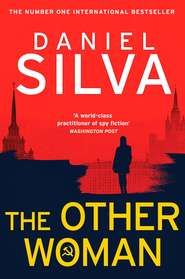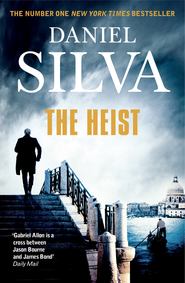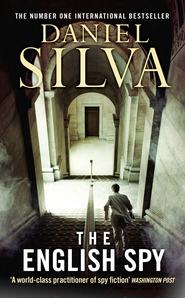По всем вопросам обращайтесь на: info@litportal.ru
(©) 2003-2024.
✖
The Fallen Angel
Настройки чтения
Размер шрифта
Высота строк
Поля
Chiara nodded. “Judging from the shape and the imagery, I’d say it comes from the upper portion of a stamnos, a Greek vase used for transporting wine. The woman is clearly a maenad, a follower of Dionysus. The instrument is a two-reed pipe known as an aulos.”
“Could it be a Roman copy of a Greek original?”
“I suppose so. But in all likelihood, it was produced in Greece two and a half millennia ago specifically for export to the Etruscan cities. The Etruscans were great admirers of Greek vases. That’s why so many important pieces have been discovered in Etruscan tomb rooms.”
“What’s it doing in a cardboard box on Roberto Falcone’s dining room table?”
“That’s the easy part. He’s a tombarolo.”
A tomb robber.
“That would explain the dog,” said Gabriel.
“And the muddy boots at the back door. He’s obviously been doing some digging, probably quite recently.” She held up the newspaper. “It’s from last week.”
Gabriel reached into the box again and withdrew another bundle of newsprint. Inside was another section of the vase. The face of a second maenad was visible, along with the kylix, a shallow cup for drinking wine, she held in her hand. Gabriel examined the image in silence before looking at the newspaper. It contained a fragment, too—a fragment of a story about a Vatican curator who had committed suicide by hurling herself from the dome of St. Peter’s Basilica. The account neglected to mention that the curator had been conducting a secret inventory of the Vatican’s collection of antiquities. It appeared her inquiry had led her here, to the home of a tombarolo. Perhaps that alone had been enough to get her killed, but Gabriel suspected there had to be more.
He looked at the fragment of pottery again and lifted it to his nose. There was a trace of a chemical odor, not unlike the smell of the solvents he used to remove varnish from paintings. It suggested the fragment had recently been cleaned of soil and other encrustations, probably with a solution of nitrohydrochloric acid. Even an old man living alone in an unkempt house would find it difficult to be around such a smell for more than a few minutes. He would need to maintain a separate facility where objects could be left for long periods without fear of discovery.
Gabriel placed the fragment of pottery into his coat pocket and looked out the window toward the tumbledown outbuilding at the back of the property. Pacing outside, head down, ears back, was Falcone’s dog. Gabriel sighed heavily. Then he went into the kitchen, found a large mixing bowl, and began filling it with anything that looked remotely edible.
There were two padlocks, German made, rusted by rain. Gabriel picked them as the dog supped greedily on a casserole of canned tuna, fava beans, artichoke hearts, and condensed milk. When the door swung open, the animal looked up briefly but paid Gabriel and Chiara no heed as they slipped inside. Here the stench of acid was overwhelming. Gabriel groped blindly, one hand covering his nose and mouth, until he found the light switch. Overhead a row of fluorescent lamps flickered to life, revealing a professional-grade laboratory built for the care and storage of looted antiquities. Its neatness and order stood in stark contrast to the rest of the property. One object looked slightly out of place, a javelin-like iron pike suspended horizontally on a pair of hooks. Gabriel examined the traces of mud near the tip. It was the same color and consistency as the mud on the boots.
“It’s a spillo,” Chiara explained. “The tombaroli use it to probe for underground burial chambers. They insert it into the ground until they hear the telltale clank of a tomb room or a Roman villa. Then they bring in the shovels and the backhoes and grab whatever they can find.”
“And then,” said Gabriel, looking around, “they bring it here.”
He walked over to Falcone’s worktable. Clean and white, it was similar to the tables in the restoration lab at the Vatican Museums. At one end was a stack of scholarly monographs dealing with the antiquities of the Roman, Greek, and Etruscan empires—the same sort of books Gabriel had seen in Claudia Andreatti’s apartment. One of the volumes lay open to an image of a red-figure Attic stamnos vase decorated with maenads.
Gabriel snapped a photo of the open page with his BlackBerry before making his way over to Falcone’s storage shelves. Chrome and spotless, they were lined with antiquities arranged by type: pottery, household utensils, tools, weapons, and bits of iron that looked as though they had been extracted from the basement of time. It was evidence of looting on a massive scale. Unfortunately, it was a crime that could never be undone. Ripped from their original settings, these antiquities now said very little about the people who had made and used them.
At the far end of the building were four large stainless steel pools, approximately five feet in diameter and three feet in height. In the first three vats, there were bits of pottery, statuary, and other objects clearly visible in the reddish liquid. But in the fourth, the acid was opaque and very close to spilling over the side. Gabriel retrieved the spillo and inserted it gently into the liquid. Just beneath the surface, it collided with something soft and pliant.
“What is it?” asked Chiara.
“I could be wrong,” Gabriel said, wincing, “but I think we just found Roberto Falcone.”
10
PIAZZA DI SANT’IGNAZIO, ROME
IN THE HEART OF ROME, between the Pantheon and the Via del Corso, is a pleasant little square called the Piazza di Sant’Ignazio. On the northern side stands a church by the same name, best known for a glorious ceiling fresco painted by the Jesuit brother Andrea Pozzo. On the southern flank, across an expanse of gray paving stones, is an ornate palazzo with façades of creamy yellow and white. Two official flags fly from its third-floor balcony, and above the solemn entrance is the seal of the Carabinieri. A small plaque states that the premises are occupied by the Division for the Defense of Cultural Patrimony. But within the world of law enforcement, the unit is known simply as the Art Squad.
At the time of its formation in 1969, it was the only police organization anywhere in the world dedicated exclusively to combating the lucrative trade in stolen art and antiquities. Italy surely had need of such a unit, for it was blessed with both an abundance of art and countless professional criminals bent on stealing every last bit of it. During the next two decades, the Art Squad brought charges against thousands of people suspected of involvement in art crime and made numerous high-profile recoveries, including works by Raphael, Giorgione, and Tintoretto. Then the institutional paralysis began to set in. Manpower dwindled to a few dozen retirement-age officers—many of whom knew next to nothing about art—and inside the graceful palazzo, work proceeded at a decidedly Roman pace. It was said by the unit’s legion of detractors that more time was spent debating where to have lunch than searching for the museum’s worth of paintings that went missing in Italy each year.
That changed with the arrival of General Cesare Ferrari. The son of schoolteachers from the impoverished Campania region, Ferrari had spent his entire career battling the country’s most intractable problems. During the 1970s, a time of deadly terrorist bombings in Italy, he helped to neutralize the Communist Red Brigades. Then, during the Mafia wars of the 1980s, he served as a commander in the Camorra-infested Naples division. The assignment was so dangerous that Ferrari’s wife and three daughters were forced to live under twenty-four-hour guard. Ferrari himself was the target of numerous assassination attempts, including a letter bomb attack that claimed two of his fingers and his right eye. His ocular prosthesis, with its immobile pupil and unyielding gaze, left some of his underlings with the unnerving sense that they were staring into the all-seeing eye of God. Ferrari used the eye to great effect in coaxing low-level criminals to betray their superiors. One of the bosses Ferrari eventually brought down was the mastermind of the letter bombing. After the mafioso’s conviction, Ferrari made a point of personally escorting him to the cell at Naples’ festering Poggioreale prison where he would spend the rest of his life.
The posting to the Art Squad was supposed to be a reward for a long and distinguished career. “Shuffle paper for a few years,” the chief of the Carabinieri told him, “and then retire to your village in Campania and grow tomatoes.” Ferrari accepted the appointment and then proceeded to do exactly the opposite. Within days of arriving at the palazzo, he informed half the staff their services were no longer needed. Then he set about modernizing an organization that had been allowed to atrophy with age. He replenished the ranks with aggressive young officers, sought authority to tap the phones of known criminal operatives, and opened offices in the parts of the country where the thieves actually stole art, especially in the south. Most important, he adopted many of the techniques he had used against the Mafia during his days in Naples. Ferrari wasn’t much interested in the street-level hoods who dabbled in art theft; he wanted the big fish, the bosses who brought the stolen goods to market. It did not take long for Ferrari’s new approach to pay dividends. More than a dozen important thieves found themselves behind bars, and statistics for art theft, while still astonishingly high, showed improvement. The palazzo was no longer a retirement home; it was the place where many of the Carabinieri’s best and brightest went to make their name. And those who didn’t measure up found themselves in Ferrari’s office, staring into the unforgiving eye of God.
A career in Italian government spanning some four decades had left the general with a limited capacity for surprise. Even so, he was admittedly taken aback to see the legendary Gabriel Allon stepping through the entrance of his office early that evening, trailed by his beautiful and much younger Venetian-born wife, Chiara. The chain of events that brought them there had been set in motion four hours earlier, when Gabriel, gazing down at the partially emulsified body of Roberto Falcone, came to the disheartening realization that he had stumbled upon a crime scene that could not possibly be fled. Rather than contact the authorities directly, he rang Donati, who in turn made contact with Lorenzo Vitale of the Vatican police. After an unpleasant conversation lasting some fifteen minutes, it was decided that Vitale would approach Ferrari, with whom he had worked on numerous cases. By late afternoon, the Art Squad was on the ground in Cerveteri, along with a team from the Lazio division’s violent crimes unit. And by sunset, Gabriel and Chiara, having been relieved of their weapons, were in the back of a Carabinieri sedan bound for the palazzo.
The walls of Ferrari’s office were hung with paintings—some badly damaged, some without frames or stretchers—that had been recovered from art thieves or dirty collectors. Here they would remain, sometimes for many weeks or months, until they could be returned to their rightful owners. On the wall behind his desk, aglow as if newly restored, hung Caravaggio’s Nativity with St. Francis and St. Lawrence. It was a copy, of course; the real version had been stolen from the Church of San Lorenzo in Palermo in 1969 and had never been seen since. Finding it was Ferrari’s obsession.
“Two years ago,” he said, “I thought I’d finally located it. A low-level art thief told me he knew the house in Sicily where the painting was being hidden. He offered to tell me in exchange for not sending him to prison for stealing an altarpiece from a village church near Florence. I accepted the offer and raided the property. The painting wasn’t there, but we found these.” Ferrari handed Gabriel a stack of Polaroid photographs. “Heartbreaking.”
Gabriel flipped through the Polaroids. They depicted a painting that had not fared well after more than forty years underground. The edges of the canvas were badly frayed—the result of the painting being cut from its stretcher with a razor—and deep cracks and abrasions marred the once glorious image.
“What happened to the thief who gave you the tip?”
“I sent him to prison.”
“But the information he gave you was good.”
“That’s true. But it wasn’t timely. And in this business, timing is everything.” Ferrari gave a brief smile that did not quite extend to his prosthetic eye. “If we do ever manage to find it, the restoration is obviously going to be difficult, even for a man of your skills.”
“I’ll make you a deal, General. If you find it, I’ll fix it.”
“I’m not in the mood for deals just yet, Allon.”
Ferrari accepted the Polaroids of the lost Caravaggio and returned them to their file. Then he stared contemplatively out the window in the manner of Bellini’s Doge Leonardo Loredan, as if debating whether to send Gabriel across the Bridge of Sighs for a few hours in the torture chambers.
“I’m going to begin this conversation by telling you everything I know. That way, you might be less tempted to lie to me. I know, for example, that your friend Monsignor Donati arranged for you to restore The Deposition of Christ for the Vatican Picture Gallery. I also know that he asked you to view the body of Dottoressa Claudia Andreatti while it was still in the Basilica—and that, subsequently, you undertook a private investigation of the circumstances surrounding her unfortunate death. That investigation led you to Roberto Falcone. And now it has landed you here,” Ferrari concluded, “in the palazzo.”
“I’ve been in far worse places than this.”
“And you will be again unless you cooperate.”
The general lit an American cigarette. He smoked it somewhat awkwardly with his left hand. The right, the one missing two fingers, was concealed in his lap.
“Why was the monsignor so concerned about this woman?” he asked.
Gabriel told him about the review of the Vatican’s antiquities.
“I was led to believe it was nothing more than a routine inventory.”
“It might have started that way. But it appears that somewhere along the line, Claudia uncovered something else.”
“Do you know what?”
“No.”
Ferrari scrutinized Gabriel as if he didn’t quite believe him. “Why were you sniffing around Falcone’s place?”
“Dr. Andreatti was in contact with him shortly before her death.”
“How do you know this?”
“I found his phone number in her records.”











